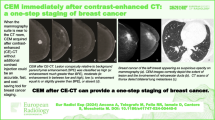Abstract
Calcification causes mixed signal intensity in the lymph node (LN) on high-resolution magnetic resonance imaging (MRI), which is a strong indicator of regional LN metastasis in rectal cancer. Calcified metastatic LNs in rectal cancer commonly display scattered fine punctate calcifications to varying degrees on computed tomography (CT). On high-resolution MRI, the calcifications manifest a patchy area of signal loss in corresponding calcified area that is larger than on CT. It is necessary to recognize the appearance of metastatic LN calcifications on high-resolution MRI in rectal cancer because it is the primary imaging method for local staging in rectal cancer. This pictorial essay aims to introduce an important imaging finding that can contribute to the diagnosis of LN metastasis by illustrating features and differences between CT and high-resolution MRI of metastatic LN calcifications in rectal cancer.









Similar content being viewed by others
References
Benson AB, Venook AP, Al-Hawary MM, Cederquist L, Chen YJ, Ciombor KK, et al. Rectal cancer, version 2.2018, NCCN clinical practice guidelines in oncology. J Natl Compr Cancer Netw. 2018;16(7):874–901 (PubMed PMID: 30006429. Epub 2018/07/15).
Beets-Tan RGH, Lambregts DMJ, Maas M, Bipat S, Barbaro B, Curvo-Semedo L, et al. Magnetic resonance imaging for clinical management of rectal cancer: updated recommendations from the 2016 European Society of Gastrointestinal and Abdominal Radiology (ESGAR) consensus meeting. Eur Radiol. 2018;28(4):1465–75 (PubMed PMID: 29043428. Pubmed Central PMCID: PMC5834554. Epub 2017/10/19).
Brown G, Richards CJ, Bourne MW, Newcombe RG, Radcliffe AG, Dallimore NS, et al. Morphologic predictors of lymph node status in rectal cancer with use of high-spatial-resolution MR imaging with histopathologic comparison. Radiology. 2003;227(2):371–7 (Epub 2003/05/07. English).
Chen Y, Wen Z, Liu Y, Yang X, Ma Y, Lu B, et al. Value of high-resolution MRI in detecting lymph node calcifications in patients with rectal cancer. Acad Radiol. 2020;27(12):1709–17 (PubMed PMID: 32035757. Epub 2020/02/10).
Rominger CJ, Centrone JF, Thompkins LJ. Calcified lymph node metastasis from carcinoma of the rectum. Am J Surg. 1969;117(3):410–2 (PubMed PMID: 5777726. Epub 1969/03/01).
Sweeney DJ, Low VH, Robbins PD, Yu SF. Calcified lymph node metastases in adenocarcinoma of the colon. Australas Radiol. 1994;38(3):233–4 (PubMed PMID: 7945124. Epub 1994/08/01. eng).
Giachelli CM. Ectopic calcification: gathering hard facts about soft tissue mineralization. Am J Pathol. 1999;154(3):671–5 (Pubmed Central PMCID: PMC1866412. Epub 1999/03/18. eng).
Moon WK, Kim SH, Cho JM, Han MC. Calcified bladder tumors. CT features. Acta Radiol. 1992;33(5):440–3 (PubMed PMID: 1327026. Epub 1992/09/01. eng).
Wnorowski AM, Menias CO, Pickhardt PJ, Kim DH, Hara AK, Lubner MG. Mucin-containing rectal carcinomas: overview of unique clinical and imaging features. AJR Am J Roentgenol. 2019;17:1–9 (PubMed PMID: 30995095. Epub 2019/04/18).
Wiersma ES. De novo calcification in lymph node metastasis. Diagn Imaging Clin Med. 1986;55(4–5):282–4 (PubMed PMID: 3639808. Epub 1986/01/01. Eng).
de Leeuw H, Stehouwer BL, Bakker CJ, Klomp DW, van Diest PJ, Luijten PR, et al. Detecting breast microcalcifications with high-field MRI. NMR Biomed. 2014;27(5):539–46 (PubMed PMID: 24535752. Epub 2014/02/19).
van Griethuysen JJM, Bus EM, Hauptmann M, Lahaye MJ, Maas M, Ter Beek LC, et al. Gas-induced susceptibility artefacts on diffusion-weighted MRI of the rectum at 1.5T—effect of applying a micro-enema to improve image quality. Eur J Radiol. 2018;99:131–7 (Epub 2018/01/25).
Heijnen LA, Lambregts DM, Martens MH, Maas M, Bakers FC, Cappendijk VC, et al. Performance of gadofosveset-enhanced MRI for staging rectal cancer nodes: can the initial promising results be reproduced? Eur Radiol. 2014;24(2):371–9 (PubMed PMID: 24051676. Epub 2013/09/21).
Fatemi-Ardekani A, Boylan C, Noseworthy MD. Identification of breast calcification using magnetic resonance imaging. Med Phys. 2009;36(12):5429–36 (PubMed PMID: 20095255. Epub 2010/01/26. eng).
Gawne-Cain ML, Hansell DM. The pattern and distribution of calcified mediastinal lymph nodes in sarcoidosis and tuberculosis: a CT study. Clin Radiol. 1996;51(4):263–7 (PubMed PMID: 8617038. Epub 1996/04/01).
Acknowledgements
We great thank Margaret Pui for her time and valuable contributions to the pictorial essay.
Funding
Support by Guangdong Basic and Applied Basic Research Foundation (2020A1515010796).
Author information
Authors and Affiliations
Contributions
SY contributed to the study conception and design. The first draft of the manuscript was written by YC and ZW and all authors commented on previous versions of the manuscript. All authors read and approved the final manuscript. YC and ZW contributed equally to this work and should be considered as co-first authors.
Corresponding author
Ethics declarations
Conflict of interest
The authors declare that they have no conflict of interest.
Informed consent
Informed consent was obtained from all individual participants included in the study.
Ethical approval
All procedures performed in studies involving human participants were in accordance with the ethical standards of the institutional and/or national research committee and with the 1964 Helsinki declaration and its later amendments or comparable ethical standards.
Additional information
Publisher's Note
Springer Nature remains neutral with regard to jurisdictional claims in published maps and institutional affiliations.
About this article
Cite this article
Chen, Y., Wen, Z., Ma, Y. et al. Metastatic lymph node calcification in rectal cancer: comparison of CT and high-resolution MRI. Jpn J Radiol 39, 642–651 (2021). https://doi.org/10.1007/s11604-021-01108-6
Received:
Accepted:
Published:
Issue Date:
DOI: https://doi.org/10.1007/s11604-021-01108-6




